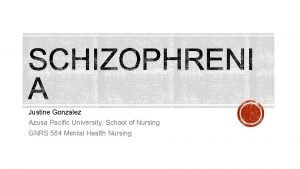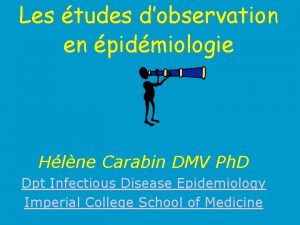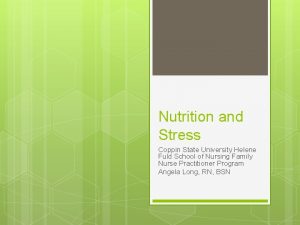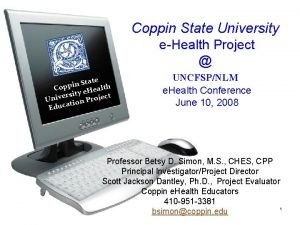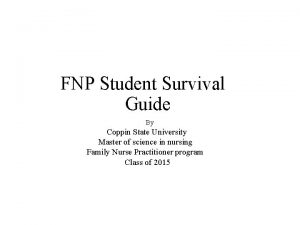Coppin State University Helene Fuld School of Nursing












- Slides: 12

Coppin State University Helene Fuld School of Nursing Family Nurse Practitioner Program NURS 500: Principles of Biomedical Ethics The Willowbrook Study in the context of moral principles. Presented by Group 2: Charlesetta Johnson Christiana Ikome Kimberly Jenkins Shanakay Haughton Presented To: Professor Emmanuel Obiako Date 07/18/2013.

Introduction-Willowbrook State School • Founded: 1938 by the legislature of the State of New York. • Purpose : Additional institution to assist with the needs of “mentally retarded children”(). • Built on 375 acres of land in Willowbrook, Staten Island. • October 24, 1947, the first group of 10 patients was admitted to the school.

Population Served According to the school served "the most handicapped, and the most helpless of those being cared for in the New York State system. Total population grew to about 6, 000 …. 77% severely or profoundly retarded, 60% were not toilet trained, 39% who were not ambulatory, 30% who had convulsive seizures, and 64% who were incapable of feeding them-selves"(). Population of patients, created the ideal atmosphere for the spread of hepatitis, by the 1950 s the yearly attack rate of hepatitis with jaundice was 25 per 1000 among the children and 40 per 1000 among the adults. Because of the uncontrollable spread of hepatitis the decision was made in 1955 to "conduct well designed studies to shed new light on the natural history and prevention of the disease"().

Premise for the purposed Studies at Willowbrook • That newly admitted residents would have greater than 90% chance of contracting hepatitis A and B. • Hepatitis was known to have a mild course in children between ages 3 to 10 years if age. • That "the artificially induced infection would induce immunity to the endemic strain of hepatitis virus…. the expectation was that artificially induced hepatitis would induce prophylactic effect"().

Overview -Willowbrook • Study setting: specially equipped units at the facility, secluded from the other areas at Willowbrook with high rates of infectious diseases like hepatitis. • The study began in 1956, investigators sent out letters of consent to parents. • Approved by the New York University School of Medicine, The New York state Department of Health , The New York State Department of Mental Hygiene and the Armed Forces Epidemiological Board. • Guidelines conformed to the Code of Ethics on Human Experimentation of the World Medical association. • Researchers emphasized: Willowbrook only used due to severe hepatitis problem at the school and not because "we were looking for a facile guinea pig population"().

Review of Literature BACK GROUND Source of literature Reviewed Literature Review Based On: Review of relevant, is from Medline, CINAHL, Health and Wellness Journals, and peer review journals. • • At least 3 articles from 2003 -2012 were reviewed The principle of autonomy Nonmalefiecence Beneficence Justice

Gordon, J. , Rauprich, O. , & Vollmann, J. (2011), Applying the four-principle approach Willobrook Experiment • Emphasized ethical judgment, to determine whether subjects can give consent - autonomy • Not be in harm’s way – nonmalefiecence • Benefit from the study – Beneficence • Determine if such research is fair in terms of risks and benefits Justice. • The subjects, all children, mentally defective persons • Unable to consent • Put in harm’s way by being deliberately infected with the hepatitis virus • Justice - Why wasn’t the research conducted on adults first?

Welie, S. K. , & Berghmans, R. P. (2006). Issues and recommendations: research involving vulnerable groups - • Examined historical background to unethical research involving human subjects - Nazi Germany - Japan - USA • Questioned if research involving persons who have severe psychiatric illnesses is permissible Willobrook Experiment • Children with mental retardation were institutionalized and consciously infected with hepatitis by the investigators with the aim of determining the period of infectivity of the virus

Maschke, K. J. (2003), United States and United Kingdom’s policies governing research with humans • Responsibilities of ethics review committees in terms of : ▫ Policies governing human subject research Willobrook Experiment • The research protocol was reviewed and approved by state, university, and federal review boards.

Biomedical Ethic Violations Autonomy, Nonmaleficence and Beneficence Autonomy Violations: • Study performed on persons with diminished autonomy: mental imparity and Low level of capacity and competence • Disclosure of potential risks were not included in informed consent • Coercion: no housing for child unless enroll in hepatitis study Nonmaleficence Violations: • Infected residents with low-dose serum” of Hepatitis A • Newly infected residents developed vomiting, jaundice and hepatomegaly • Negligence of proper hand hygiene Beneficence Violations Willowbrook State School was allowed to become over-crowded; hence, increase risk of spread of Hepatitis B

Willowbrook Study Effect On Future Studies. Regulations • The principle of respect for person • Protection of human subject regulation • Nuremberg code • Declaration of Helsinki

References: Beauchamp, T. , & Childress, J. (2009). Principles of biomedical ethics. (6 th ed. ) New York, NY: Oxford University Press, Inc. CDC (2013). Hepatitis A faq’s for the public. http: //www. cdc. gov/hepatitis/A/a. FAQ. htm#transmission Robinson, W. , & Unruh, B. (2008). A selected history of research with humans: the hepatitis experiments of the Willowbrook state school. Pp. 80 -85
 Helene fuld health trust
Helene fuld health trust California state university long beach nursing
California state university long beach nursing Fort valley state university nursing
Fort valley state university nursing Azusa pacific school of nursing
Azusa pacific school of nursing Welcome to columbia university
Welcome to columbia university Helene basu
Helene basu Dancing shoes helene schjerfbeck
Dancing shoes helene schjerfbeck Helene chan
Helene chan Helene wetherington
Helene wetherington étude transversale
étude transversale Helene heath
Helene heath Wanda helene ollep
Wanda helene ollep Helene melanie lebel
Helene melanie lebel



